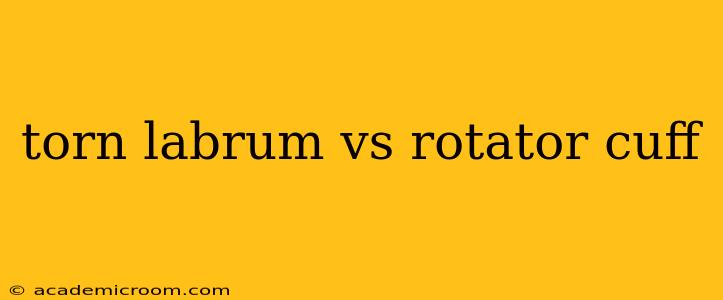Both a torn labrum and a rotator cuff injury affect the shoulder, causing pain and limiting movement. However, these are distinct conditions with different causes, symptoms, and treatments. Understanding the key differences is crucial for accurate diagnosis and effective treatment.
What is a Torn Labrum?
The labrum is a ring of cartilage that surrounds the shoulder socket (glenoid). It acts as a cushion, deepening the socket and providing stability to the shoulder joint. A torn labrum occurs when this cartilage is damaged, often due to a sudden injury like a fall or a forceful impact. Repetitive overhead movements can also contribute to a tear over time. The tear can be partial or complete, and its location within the labrum influences the symptoms experienced.
Symptoms of a Torn Labrum:
- Shoulder pain: This can range from mild discomfort to severe pain, depending on the severity of the tear.
- Clicking or popping: Many people report hearing or feeling a clicking or popping sensation in their shoulder.
- Instability: The shoulder may feel unstable or like it might dislocate.
- Limited range of motion: Lifting the arm overhead or reaching behind the back may be difficult or painful.
- Weakness: Shoulder weakness is common, particularly when lifting or performing certain movements.
What is a Rotator Cuff Tear?
The rotator cuff is a group of four muscles and their tendons that surround the shoulder joint. These muscles help to stabilize the shoulder and enable a wide range of motion. A rotator cuff tear occurs when one or more of these tendons are damaged, either partially or completely. This is often caused by repetitive overuse, trauma, or age-related degeneration.
Symptoms of a Rotator Cuff Tear:
- Shoulder pain: Pain is frequently felt on the outside of the shoulder and may radiate down the arm.
- Weakness: Significant weakness, especially when lifting or rotating the arm, is a common symptom.
- Limited range of motion: Similar to a labrum tear, the range of motion may be restricted, often more significantly.
- Night pain: Pain may worsen at night, especially when lying on the affected side.
- Atrophy: Muscle wasting or atrophy may be visible in the shoulder area over time.
Torn Labrum vs. Rotator Cuff: Key Differences Summarized
| Feature | Torn Labrum | Rotator Cuff Tear |
|---|---|---|
| Affected Area | Glenoid labrum (cartilage ring) | Rotator cuff tendons and muscles |
| Primary Cause | Sudden injury, repetitive overhead movements | Repetitive overuse, trauma, age-related wear |
| Common Symptoms | Clicking/popping, instability, pain | Weakness, pain, limited range of motion, night pain |
| Diagnosis | Physical exam, MRI, arthroscopy | Physical exam, MRI, ultrasound, X-ray |
| Treatment | Physical therapy, surgery (in some cases) | Physical therapy, surgery (in some cases) |
What are the different types of rotator cuff tears?
Rotator cuff tears are categorized by size and location:
- Partial-thickness tears: These involve only a portion of the tendon.
- Full-thickness tears: The tendon is completely torn.
- Small tears: These tears are less than 1cm.
- Large tears: These tears are larger than 1cm. Larger tears are more likely to require surgery. The location of the tear, specifically whether it affects the supraspinatus tendon, significantly influences treatment decisions.
What are the different types of labral tears?
Labral tears are classified based on their location and morphology:
- SLAP tears (Superior Labrum Anterior to Posterior): This is a specific type of labral tear affecting the upper part of the labrum.
- Bankart lesions: These occur at the anterior (front) part of the labrum, often associated with shoulder dislocations.
- Posterior labral tears: These affect the posterior (back) part of the labrum.
How are torn labrums and rotator cuff tears diagnosed?
Diagnosis typically involves a physical examination, which assesses range of motion, strength, and stability. Imaging tests like MRI scans are invaluable for visualizing the extent of the tear. In some cases, an arthroscopy (a minimally invasive surgical procedure) might be used to confirm the diagnosis and possibly repair the tear.
How are torn labrums and rotator cuff tears treated?
Treatment approaches vary depending on the severity of the injury and the individual's activity level. Conservative management, which includes rest, ice, physical therapy, and medication, is often the first line of defense. Surgical intervention may be considered if conservative treatment fails to provide relief or if the tear is significant. Surgical techniques range from arthroscopic repair to open surgery. The specific surgical approach selected depends on several factors including the patient’s age, activity level, and the type and location of the tear.
This information is for general knowledge and does not constitute medical advice. Always consult with a healthcare professional for accurate diagnosis and treatment of any shoulder pain or injury.
